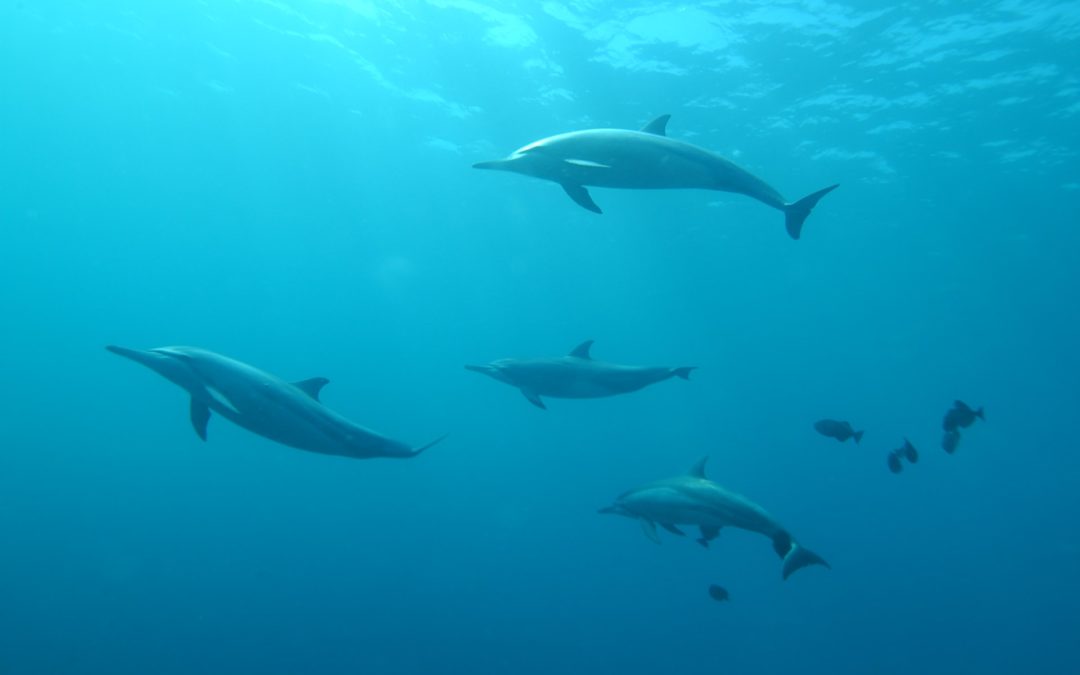Dolphins would come up and play in the bow wave of the ship. These intelligent mammals (brain to body ratio is second only to humans) would sometimes play for hours, jumping in and out of the wave caused by the ship cutting through the water. Dolphins are curious and attracted to the engine sounds. Once they were near, the bow wave seemed to be a lot of fun. I could lean over the bow and watch for hours.
Dolphins are mammals. They breathe air, have hair (at least a few present at birth), and nurse their young with milk. Like people, they are usually very mild-tempered, but dolphins (and people) can be quite aggressive.
Dolphins form strong bonds within their pods. Young will stay with the mother for 2 to 3 years. (The dolphin is the only mammal that gives birth with the tail first instead of the head.) The intense bonds mean that they have been observed caring for the sick, the elderly, and those that have been injured with great care. Perhaps that is why they have rescued humans and helped humans fish. Most dolphins are marine or saltwater dolphins, but there are five species of river dolphins. All dolphins are athletic, but some marine dolphins can jump up to 30 feet in the air. Because they are mammals, they have to come to the surface to breathe. In the bow waves, this might be every 20 seconds, but some species can dive for 30 minutes between breaths and dive up to 1000 feet.
Dolphins are members of the toothed whale species. Toothed whales have teeth and only one blowhole (baleen whales have two). A blowhole is a nostril on the top of the head where they blow air out as they surface and then take in air when they come to the surface. Although dolphins and porpoises are toothed whales, they are generally smaller than most baleen whales. Another member of this family, the sperm whale, is 13 to 18 meters.
Dolphins have 100 teeth that they use to grab and hold fish before swallowing them whole. Dolphins can eat up to thirty pounds of fish a day. Working as a team and swimming up to 25 mph, they surround the fish school and cause the fish to become a compact ball. Then they scoop through the middle of the ball and virtually inhale the fish. But they are not limited to this one method of fishing and will change methods to maximize their catch. They will cooperate with other pod members and very rarely try to fish on their own. They use echolocation for navigation and as a big part of overall pod communication. Echolocation is done through the melon in the head. Like cows, they have multiple stomachs. In dolphins, the first stores food, and the second one digests it.
Dolphin skin is grayish blue and extremely sensitive. It is very delicate, and it can easily be damaged by contact with other surfaces. But dolphins have a fast healing process. Even deep wounds from shark bites heal rapidly. The mechanism isn’t fully understood, but other mammals would hemorrhage and die from similar wounds. Maybe someday, I will use this in my veterinary practice.
Dolphins can be identified by their unique dorsal fin. Each one is different. This unique identification system allows us to know that some have been observed in the wild to live 50 years. The average life span is about 17.
Declining fish populations are affecting the dolphins. I don’t know if the dolphins could see me on the bow. They are able to see well in the water because their retina is uniquely adapted to gathering light. But I know I will always remember seeing them and the times that I spent on the bow, learning, and watching.

